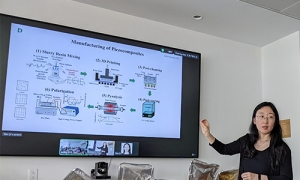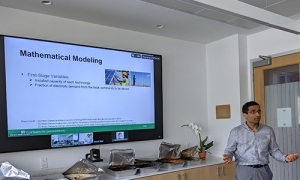On May 16th, the Irving Institute hosted its final Faculty Seminar for the 2024-2025 academic year. We extend our gratitude to professors Yan Li and Vikrant Vaze, whose insightful and inspiring presentations brought this year's series to a close. Professor Li explored the engineering of materials that harness environmental vibrations to generate usable energy, which can power a range of applications from tiny medical devices to smart cities. Meanwhile, Professor Vaze presented his team's research into AI-driven modeling techniques designed to promote green infrastructure in conflict zones across Africa.
Multifunctional Materials Design & Manufacturing
In a compelling presentation, Thayer's Assistant Professor Yan Li unveiled the transformative potential of piezoelectric materials, which have the remarkable ability to convert mechanical stress into electrical energy and vice versa. This multifunctionality, particularly in miniaturized devices, is not merely advantageous—it's critical for their effective operation. From life-saving medical devices to visionary urban infrastructure, Li's research presentation highlighted the wide-ranging applications of these materials.
Currently, pacemakers—devices that regulate heart rhythm—rely on batteries with a typical lifespan of about ten years, necessitating invasive replacement surgeries. Professor Li's innovative approach aims to integrate piezoelectric materials into pacemakers, utilizing the mechanical energy from heartbeats to generate power. This could potentially extend the device's operational lifespan, reducing the need for frequent surgical interventions and transforming patient care.
Li's research team also focuses on optimizing the design of energy-harvesting materials. By creatively layering piezoelectric materials with non-piezoelectric substrates, they've enhanced energy capture efficiencies under low-frequency conditions in lab conditions. This architecture not only amplifies the range of motion to generate more charge but also bolsters the durability of these composites in high-temperature environments, which is crucial for their real-world applications.
Exploring the dual functionalities of piezoelectric sensors, Li's team developed a compressible sensor capable of integrating acceleration, sensing, and dynamic force detection within a single device. This innovation, resembling a spring with ultra-high sensitivity, is pivotal for applications like robot-assisted surgery, where precise, smooth motion is critical. Moreover, these sensors hold promise for orthopedic implants, allowing for detailed analysis of motion patterns and forces exerted during movements.
The potential of piezoelectric materials extends well beyond miniaturized devices into the landscapes of smart cities. Japan leads the way with power-generating floors and bridges that utilize foot traffic and vehicular movement to produce electricity, powering public infrastructure sustainably. European countries also explore these materials in recreational settings, and initiatives like the California Energy Commission's proposal to pilot piezoelectric materials in a section of highway may yield results that expand options for decentralized energy solutions.
Despite their promise, the deployment of piezoelectric materials faces challenges, including cost reduction and enhancing durability under diverse environmental conditions. Professor Li's forward-thinking approach adapts advanced design methodologies, including few-shot learning models, to refine material architectures. As researchers like Li continue to explore and refine the applications of piezoelectric materials, a more energy-efficient world comes into clearer focus, where seemingly wasted vibrations are transformed into valuable resources for a sustainable future.
Developing Green Energy Infrastructure in Conflict-Affected Regions of Africa
Vikrant Vaze delivered an inspiring presentation that was developed in collaboration with his coauthors, PhD students Lilly Yang and Siqi Ke, along with undergraduate engineering student Ryan Proulx '25.
Vaze focused on his work using optimization and AI modeling to address critical issues of energy access in the world's most fragile states. Over 60% of the 685 million people without electricity live in these regions—areas troubled by unstable governance and recurring cycles of conflict.
He explained the paradox many of these regions face: despite being rich in petroleum reserves, they lack the capacity to refine these resources locally. Instead, they export crude oil and import refined fuels at high costs, creating a hazardous dependency. Tragically, this reliance is reflected in the fact that more than half of UN peacekeeping fatalities are linked to protecting fuel convoys—highlighting the urgent need for alternative energy solutions.
Vaze presented a promising approach: harnessing the abundant solar energy potential in these regions, especially in countries like the Central African Republic, South Sudan, and Somalia. With significant solar and wind resources of varying potential, the overall renewable energy opportunity is promising. He emphasized that leveraging these natural resources could help reduce dependence on diesel, lower costs, and improve both the reliability and accessibility of electricity.
Central to his presentation was a sophisticated optimization model developed by his team. This model aims to balance four key objectives: minimizing upfront costs, decreasing reliance on diesel, maximizing reliability, and expanding electricity access to local communities. It produces multiple Pareto optimal solutions, offering stakeholders the flexibility to select options that best align with their priorities.
Building this model required meticulous data collection and active stakeholder engagement. Vaze underscored the importance of collaboration with various UN agencies, local governments, and private investors to facilitate the transition to green energy.
He concluded by highlighting the broader implications of his research. The vibrant solar potential in these conflict zones offers a beacon of hope for overcoming the profound challenges of electricity scarcity and energy insecurity.
His team's work was inspired by Dartmouth's John Sloan Dickey Center for International Understanding's Powering Peace workshop in 2023. Vaze extended heartfelt thanks to his key collaborators, including Dr. Steven Peterson, senior lecturer at Thayer, and Dickey Center partners Victoria Holt, the Norman E. McCulloch Jr. Director; Amy Newcomb, Strategic Projects Consultant; Noah Nicolson, Great Issues Fellow; and Anaise Boucher-Browning, also a Great Issues Fellow.
The "Developing Green Energy Infrastructure in Conflict-Affected Regions of Africa" project was made possible through support from the Arthur L. Irving Institute for Energy and Society and the John Sloan Dickey Center for International Understanding.
View the May seminar recording


